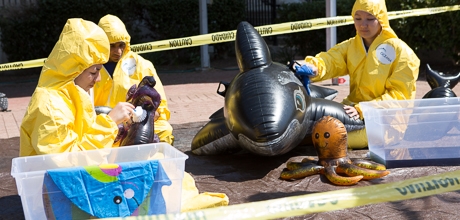At George Washington University’s Earth Day Fair on Friday, members of the university community came together to learn how the university is tackling complex problems related to sustainability and how individuals can get involved.
The Earth Month 2013 theme “What Can You Do?” focused on the individual actions that make a difference, including things like composting, studying sustainability through GW’s minor in sustainability and considering the ecological implications of things like paper purchases in university offices.
Provost Steven Lerman spoke about the four dimensions of sustainability at GW and how the university is focusing on practice, curriculum, research and outreach.
“We’re really trying to walk the walk as a university,” Dr. Lerman said. In the practice dimension, GW has five LEED Gold-certified buildings, with eight more in the pipeline, and in the curriculum dimension, GW’s new minor in sustainability already has 62 students enrolled. He cited five faculty members, each from a different department, who team-teach an introductory sustainability course, bringing in elements from a variety of academic disciplines. This sort of cooperation is what will make future sustainability projects successful, he said. One example is GW’s Solar Decathlon team, which is competing in a prestigious national challenge to build a sustainable home for a returning veteran.
“We want to be agile in bringing together interdisciplinary teams around sustainability,” Dr. Lerman said.
He also cited research happening across disciplines on questions of ecological change and sustainability. GW’s unique location in the center of the federal city provides the university with important opportunities to influence policymakers on questions of sustainability, he said.
Director of the Office of Sustainability Meghan Chapple-Brown described how GW is part of a complex urban ecosystem—one which we all have the responsibility to help protect and improve. In the coming year, GW will work on taking steps toward its goal of becoming a zero-waste campus, and will continue to work on ways to reduce its carbon footprint and use water responsibly. In addition, the university will focus on how its sustainability decisions influence different groups of people.
“Equality, social justice, diversity and inclusion are important parts of the sustainability world, and we’re thinking about that more and more,” Ms. Chapple-Brown said. “We’re looking at GW’s risks and opportunities to change that broader ecosystem and make it healthier.”
Reducing waste—including hazardous e-waste—is especially important because most of the people who live within a few miles of hazardous waste sites are people of color and others who historically haven’t had their voices heard, she said.
Ms. Chapple-Brown invited attendees to the Earth Day Fair to get as involved in GW’s sustainability efforts as individuals, starting with composting their drink cups before leaving.
Dr. Lerman emphasized that despite our individual actions, we’re all in this together.
“In reality, it should Earth Day every day…we all live here on earth and as far as I know, not many of us are leaving. We need to do whatever we can to create a sustainable environment.”


